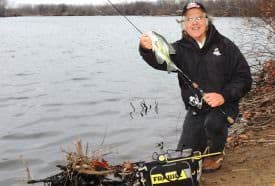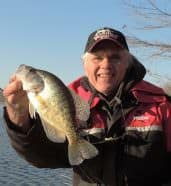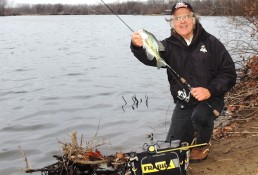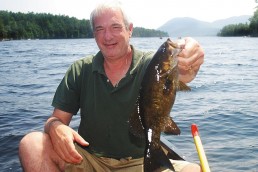Slow Runner
SHARE THIS POST
As the ice starts to leave, and spring’s open waters start warming up, fish get a little more active and searching out new areas. At the same time, they are still in or near their wintering spots, and while a lot of fish can be found along late spring areas on a warm day, these other spots are still prime for suspended panfish.
It is at this time I like to fish what I call a “slow runner” or to be more precise, a slowly retrieved
Road Runner. Fishing a Road Runner is normally done with a slower pace, but this is even slower, and at times using a “rocking” technique with a float. In fact, the prime way of fishing the “slow runner” is using it under a float.
There are several floats that I’ve used, especially Mick Thill’s creations, but recently fellow outdoor writer, Don Banning, introduced me to the Mr. Crappie pear-shaped Rattlin’ Float, which is manufactured by Betts Tackle. This series of floats has added something different—rattles—and as everyone knows my passion for Rat-L-Traps, you know a float of that type would peak my interest. These are available in three sizes, of which I prefer the smallest. They also ad weight for casting.

The next thing is the type of Road Runner used. The best I’ve found for this style of fishing for panfish is the Natural Science Trout & Panfish model. These are available in three sizes: 1/32-, 1/16- and 1/8-ounce. I use the smaller size for less aggressive fish, and will normally start with the 1/16 ounce. The 1/8 ounce will be used if larger fish are aggressive or hitting and getting away due to the smaller lure sizes. There are several colors available, but sticking with the basics of white, chartreuse and black will do nicely. In fact, most of the time I use something with a whitish type color like a pearl, lemon/pearl or Mayfly.
Rigging is very simple. Clip the float on the line at whatever depth is desired. For deeper settings and longer casts, I like using a Berkley C-Series rod, 10-foot model. Otherwise, I use a Shakespeare seven-foot Agility ultralight spinning rod. Both are teamed with Pflueger Supreme ultralight spinning reels and 8-pound-test Nanofil line.
Now it is time to use the rig. There are three basic retrieves: constant, go-and-pause, and “rocking.” With all three, be sure to cast past the area that is holding fish, and work the lure over the spot, whether it is a brush pile, rocks, island, weed beds or edges of weed lines, which in most cases would be fished parallel.
Are you enjoying this post?
You can be among the first to get the latest info on where to go, what to use and how to use it!
With the constant retrieve, it is nothing more that keeping the lure coming at a continuous, but very slow speed that is just fast enough to turn the small willow leaf spinner. This can also be used with my “finger jigging” technique, which I use quite often. It will put the Rattlin’ Float to work as it bounces along with the throbbing of the rod tip.

The go-and-pause retrieve is simply using the constant retrieve, with pauses about every 2 to 3 feet to start, but varying if the fish are hitting a little slower. The pauses are long enough to allow the lure to drop all the way back to the set depth. This is a good retrieve for crappie when they are hitting lures on the fall.
“Rocking” the lure is where the Rattlin’ Float can truly come into play. With this the rod tip is used to pull the float a foot and stopping to allow the Road Runner to flutter back. It is similar to the go-and-pause retrieve, but with a shorter pull, and not done with the reel handle, except to wind up slack. This retrieve, as with the go-and-pause, works best on crappie that are striking lures that are falling. The flutter action of the Road Runner’s willow blade on the fall makes it ideal for both of these techniques.
The “rocking” retrieve can also be used in conjunction with a bobbing retrieve that is used when there is a chop on the water that gives the jig an up and down motion with the constant wave action bobbing the float. At this time I will also have a rig set up with a Blitz Crappie Jig that has a marabou skirt. Most of the time in this situation the lure is drifted with the wind and wave action, and not given much extra retrieve other than some direction control.
With both the Road Runner and Crappie Jig, I will add Berkley Crappie Nibbles, Gulp Waxies and live waxworms. Crappie Nibbles are normally the primary choice, especially for the Road Runner. With the Crappie Jig, I will place up to three Nibbles on the hook’s shank, which will often saturate the marabou.
Whether fishing from a boat, or shore, give the “slow runner” system a try, and I’m sure you will be pleased with the results. I’ve caught a lot of nice bluegill and crappie fishing this method. It is probably the only time that a slow runner will win the prize.
MWO
SHARE THIS POST
Did you enjoy this post?
You can be among the first to get the latest info on where to go, what to use and how to use it!
Dan Galusha
Dan Galusha has fished all of his life, worked more than 45 years in the outdoor/media industry, and was inducted into the Fresh Water Fishing Hall of Fame as a Legendary Communicator. Direct questions through dansfishntales.com, facebook.com/dansfishntales and facebook.com/shootnplink.



